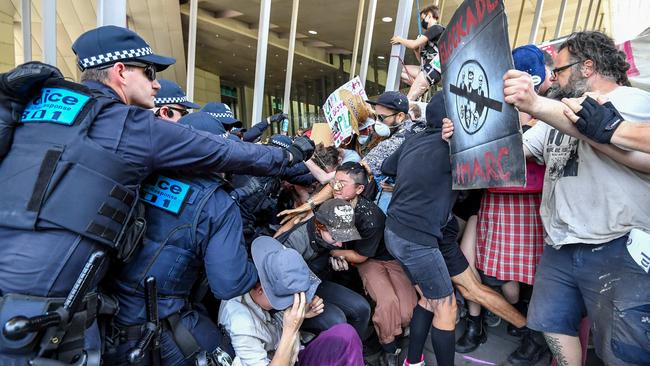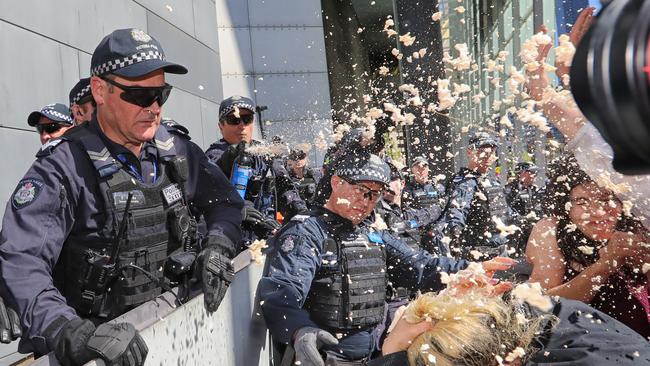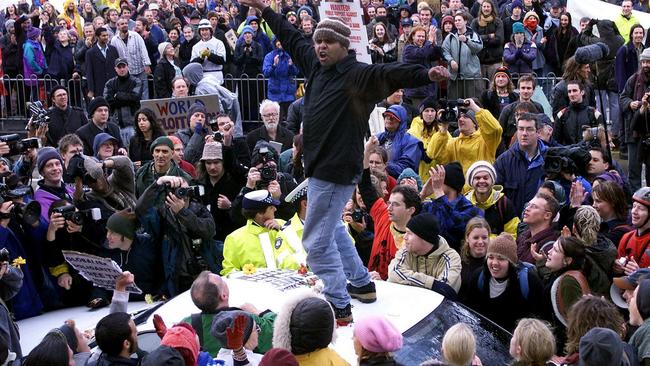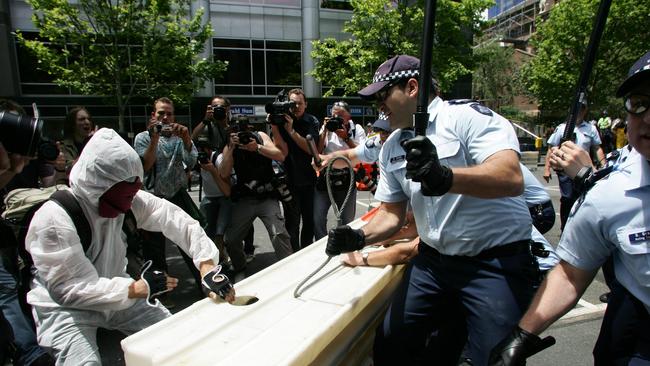Melburnians take to the streets
Protests in Melbourne are not new, but the decision by the hard left to seize on climate is a worrying development.

The rise of a coalition of hard-left climate-change protesters in Melbourne mixed with the historical ability of unions to organise in significant numbers has this week cemented the city’s reputation as the national capital of street-based political activism.
The capacity to organise in large numbers is not necessarily a new phenomenon but the decision by the hard left to seize on climate as the vehicle to commit violence and disrupt the nation’s southern capital is an unwelcome contemporary development for police and government.
No one sensible is arguing against the right to protest. But there is a growing community belief that this right does not extend to injuring police and depriving workers and students of their ability to move freely through the city.

This week’s violence at a mining conference prompted Scott Morrison’s intervention on Friday, by calling for an end to this form of violent protesting. The Prime Minister is not, in effect, talking about Labor or mainstream unionism, but relatively small numbers of radical protesters who might once have been considered Trotskyists.
READ MORE: PM vows crackdown on ‘absolutist environmentalism’ | Melbourne activists target mining conference | Labor slams government ‘intolerance’
While the Prime Minister will no doubt attempt to link Labor to this radical new environmental activism, it has much closer connections to the Greens, which this week backed the coalition of groups campaigning on the climate issue.
It was Adam Bandt and Bob Brown who issued messages of support, with Bandt declaring: “The bottom line is, no matter what the police do, you cannot arrest your way out of global warming.”
So how did Melbourne become Australia’s protest capital? The answer is complex but almost certainly built on a disproportionately strong union presence and also a resilient cohort of hard-left activists who swing between issues as diverse as Israel, climate, land, animal and gay rights. These left activists have refined the techniques of generations of campaigners to evolve into today’s protest groups.
It is important to stress that the Labor style of activism in Victoria is significantly different to that of these hardline leftists. Violence and overt disruption to commuters is avoided. However, there have been historical examples of rough-house tactics within the party, the most entertaining being the use of rotten tomatoes at the 1985 state conference by members of a hard-left sub-faction angry with the reaffiliation of some right-wing unions.
Today the natural home of these hard-left operatives seems to be the Greens. On the extreme left are the hard-core socialists who often have connections to university campuses and groups such as the Victorian Socialists, Extinction Rebellion and Animal Activists Australia.
The old Tomato Left faction no longer exists in Victorian Labor and, while the state is ruled by the most left-wing government in the state’s modern history, it is pragmatic New Labor rather than any sort of evangelically driven administration.
There are radical outliers in some unions, particularly on some building sites, but these tend to be more associated with the pursuit of industrial strength rather than an overt desire to manipulate the political debate.
One of the keys to the history of the 200-odd protesters who violently disrupted this week's mining conference is the declared link to the 2000 S11 protests in Melbourne during meetings of the World Economic Forum, when many thousands of people protested, at times violently, in the lead up to the Sydney Olympics. While there are many examples of violent protest in Melbourne, this is one of two modern protesting benchmarks that dwarfs this week’s action at the International Mining and Resources Conference.

The second example was the 2006 G20 protests, which led to widespread chaos in the city, attacks on police horses, the ransacking of police assets and a scale of disobedience that made the force a global laughing stock under its former leadership.
Brian Boyd, the former secretary of the Victorian Trades Hall Council and a leading official of the Builders Labourers Federation in the 1980s, was one of the architects of an ostensibly new direction in protesting in the Victorian union movement.
Boyd, who became the union-police liaison during the anti-Kennett era marches and later the waterfront dispute in the late 1990s, worked with the force rather than against it in trying to minimise clashes and create a smoother protest environment that worked for both sides. “We negotiated. I called it differently from then,” Boyd said this week of the changing nature of protesting.
Even today Victorian unions can attract hundreds of thousands of people to city marches but they are carefully co-ordinated with police, they are rarely violent and they are normally timed to avoid serious traffic disruption.
The demographic of these climate protest groups is not without its complexities. Extinction Rebellion, for example, which last month caused significant disruption to inner-city Melbourne, has attracted support from well-heeled people genuinely concerned about the climate issue. It is these people the Greens seem most interested in. The Greens see a rich vein of future votes in inner-city seats from cashed-up people who are largely immune to the everyday economic shocks faced by middle Australia and are alarmed about the threats to the planet.

It would be a mistake to underestimate the value of these voters to Labor, the Coalition and the Greens. But at the same time, elections are won and lost in the middle. Which is why Morrison will see more votes, particularly in Queensland, in reining in climate protesters than in attempting to woo the left with climate policies his government could never back.
Premier Daniel Andrews denounced this week’s behaviour, even though he has done much himself to try to woo the Greens vote. Indeed, this was a centrepiece of his first-term political strategy. “Victoria Police are out there now and they are doing every one of us proud and I reject the criticisms that we’ve seen from some quarters in the past 24 hours,” he said of the police response.
“I will always support the right of every Victorian, if they so choose, to peacefully protest but there’s a big difference between peaceful protest and what we saw yesterday and potentially today.’’
Nick Economou, a senior lecturer in politics at Monash University, says one of the reasons the climate protests had attracted such large numbers in Melbourne was the CBD’s proximity to inner-city suburbs where there is strong interest in climate change. “They are all there in large numbers,’’ he tells Inquirer.
Economou says Sydney also has large numbers of young voters with proximity to places like universities, but the city had not historically protested in the same ongoing way and on the same scale.
In Melbourne, he says, there are three traditional meeting places for protesters: the parliament, Flinders Street Station and the old City Square, making it geographically easy to gather. “It should also be the same in Sydney but it doesn’t seem to be as amenable to that kind of activity.’’


To join the conversation, please log in. Don't have an account? Register
Join the conversation, you are commenting as Logout